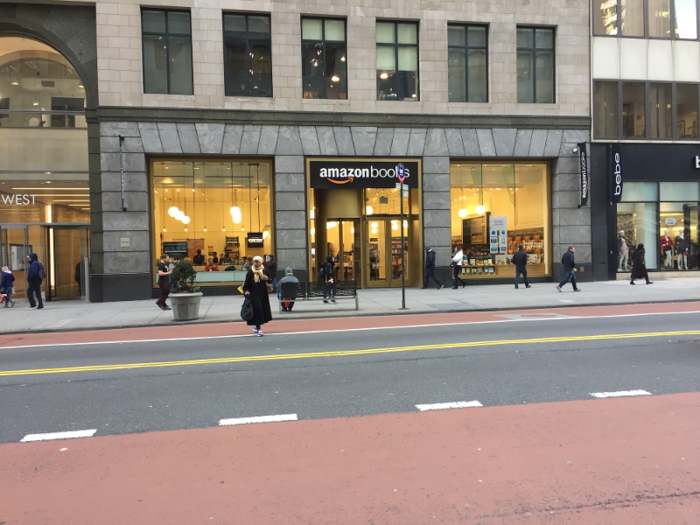

The store's shelves and displays are more compact than a traditional bookstore's, and the space is easier to navigate. But, like other bookstores, it displays far more inventory than many modern retail spaces.

Amazon wants to make the book-shopping process more efficient, but in doing so, it overwhelms shoppers with visual information. The cards beneath each book make the store look like a warehouse, and there's a reason most bookstores don't display every book with its cover facing shoppers: The variety of designs and color schemes makes it difficult to decide where to look.

Every book on display has a small card beneath it that includes its rating from Amazon customers and an excerpt from a customer review.

The store's inventory strategy emphasizes obvious selections — best-sellers, award-winners, critically-acclaimed authors — which is good and bad. On one hand, it can be helpful for readers who are looking for entry points into certain genres or who want to brush up on the classics. This comic and graphic novel display, for example, makes things simple for a newcomer.
But the strategy doesn't differentiate a physical retail store from an online one. Since many of the sorting mechanisms the store uses can be replicated on Amazon's website or with Google searches, it's difficult to understand why someone should make the effort to go to Amazon Books instead of shopping online.

To find out a book's price, you have to scan it with either the handful of machines available in the store, or on Amazon's app. Prime members get significant discounts.


Selling an e-reader in a physical bookstore is an obvious conflict of interest. But when you combine that fact with the availability of other tech devices and discounts for Prime members, it appears books may just be window-dressing for Amazon's larger goal: to encourage you to buy into a network of hardware and services that are designed to maximize the amount of shopping you do with Amazon.

Amazon's website does an excellent job of making it easy to research and sort through an enormous number of products without feeling overwhelmed. While Amazon Books couldn't possibly match the web store's variety, its organizational principles reminded me of the experience of shopping online.
But that may not be the best model for a bookstore. In an era where it's never been easier to buy a book without leaving your home, bookstores need to offer an experience that's different than shopping online. The best, like NYC's Strand, do so by having a knowledgeable staff curate displays with personal recommendations and designing their stores to encourage random discoveries.




Barnes & Noble has been struggling for years, so it's easy to understand why it would offer impulse buys like candy and discounted pop culture memorabilia to boost sales, but they make the first floor feel cluttered.


The store uses a lot of space to display products with limited appeal, like coin-collecting books and hardcover journals.

This is just a fraction of the CDs that were on sale in the store's film and music section. Given how CD sales have plummeted over the past decade, I can't imagine the demand would even come close to the store's supply.

Unsurprisingly, Barnes & Noble resembles a traditional bookstore far more than Amazon Books does. And that's a good thing, because unlike Amazon Books, I could see myself spending hours shopping at Barnes & Noble due to the variety of books available and the long, maze-like shelves that encourage random discoveries. As a result, I'd also be more likely to purchase multiple books from Barnes & Noble than at Amazon Books.

This display is a perfect example of how to catch and direct a shopper's attention. By alternating books with their covers and spines facing the shopper, the display emphasizes a handful of books without overwhelming the shopper.

Even the coffee shop, which is run by Starbucks, feels more inviting than the one at Amazon Books.

That's a shame as far as bookstores are concerned. Barnes & Noble provides a compelling, if imperfect, alternative to local bookstores in cities that can't sustain them. But its retail strategy more closely resembles those of struggling department stores — selling too many things in too big a space — than more innovative counterparts like Apple and Warby Parker.
A minimalist approach might be best for tech products, but it doesn't work as well for bookstores. The more you limit inventory, the more you defeat the purpose of going to a bookstore in the first place. Barnes & Noble is a better store than Amazon Books, but it's tied to a worse business model.
 A centenarian who starts her day with gentle exercise and loves walks shares 5 longevity tips, including staying single
A centenarian who starts her day with gentle exercise and loves walks shares 5 longevity tips, including staying single  A couple accidentally shipped their cat in an Amazon return package. It arrived safely 6 days later, hundreds of miles away.
A couple accidentally shipped their cat in an Amazon return package. It arrived safely 6 days later, hundreds of miles away. FSSAI in process of collecting pan-India samples of Nestle's Cerelac baby cereals: CEO
FSSAI in process of collecting pan-India samples of Nestle's Cerelac baby cereals: CEO Private Equity Investments
Private Equity Investments
 Having an regional accent can be bad for your interviews, especially an Indian one: study
Having an regional accent can be bad for your interviews, especially an Indian one: study
 Dirty laundry? Major clothing companies like Zara and H&M under scrutiny for allegedly fuelling deforestation in Brazil
Dirty laundry? Major clothing companies like Zara and H&M under scrutiny for allegedly fuelling deforestation in Brazil

Copyright © 2024. Times Internet Limited. All rights reserved.For reprint rights. Times Syndication Service.